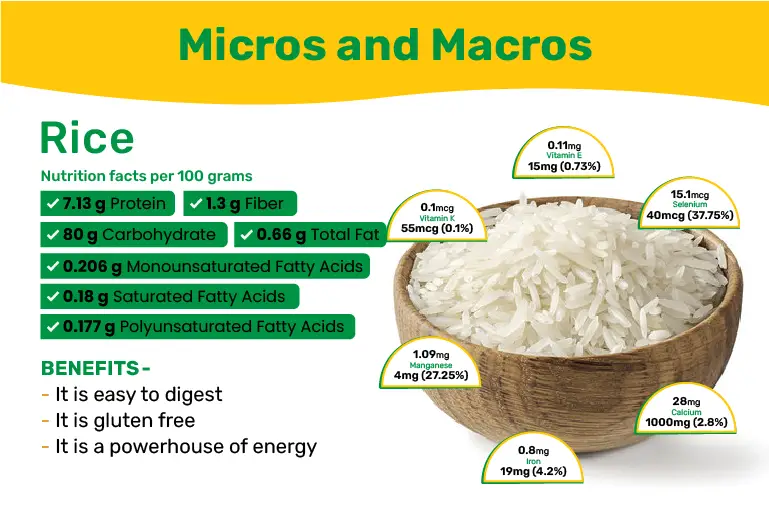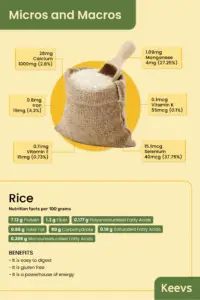Rice Nutrition Facts 100g: Rice Nutrition Facts and Health Benefits

Rice is the most common grain in Asia!
This is largely due to the climatic condition. However, this works in our favour since rice is highly nutritious and benefits our body!
Mulan, the Disney princess, ate rice for every meal, and so did our favorite cartoon character, Shin-chan.
What is it about rice and Asians, and why is it their staple?

Rice, a brief
Every region has a climatically and culturally adapted principal source of carbohydrate and protein, and in Asia, it happens to be Rice.
Rice thrives in a hot and wet climate, similar to the climate of most Asian countries. This makes growing rice convenient for most of us.
Rice, a cereal grain, is the seed of the grass species Oryza sativa. It is washed, boiled, and then consumed with a side of curry, sambar, or dal.
| India is the second-largest producer of rice in the world. We account for around 20% of the world’s produce! |
Rice contains gluten.
Myth or fact?
This is a myth because rice is actually gluten-free.
Hence, it also does not cause any allergies that are often associated with other grains. (1)
Is rice a staple in your house?
| Not really | Yes! |
Rice nutrition facts 100g
Rice has been a predominant part of our diet, but is it good or bad for our health?
The answer to this question wouldn’t just be a simple yes or no. What might be healthy for you, may be harmful for another.
Therefore, to discuss whether rice is the option for you or not, let’s take a look at its nutritional value.
The following are rice nutrition facts 100g according to the USDA. (2)
| Nutrients | Content in 100g | RDA (% of total RDA) |
| Carbohydrate | 80 g | 130 g (61.5%) |
| Selenium | 15.1 mcg | 55 mcg (27.45%) |
| Manganese | 1.09 mg | 4 mg (27.25%) |
| Protein | 7.13 g | 52 g (13.7%) |
| Phosphorus | 115 mg | 700 mg (16.4%) |
| Copper | 0.22 mg | 0.9 mg (24.4%) |
| 0.164 mg | 1.7 mg (9.6%) | |
| Zinc | 1.09 mg | 11 mg (9.9%) |
| 25 mg | 420 mg (5.9%) | |
| Fiber | 1.3 g | 30 g (4.3%) |
| Iron | 0.8 mg | 18 mg (4.4%) |
| 115 mg | 3400 mg (3.4%) | |
| Calcium | 28 mg | 1000 mg (2.8%) |
| Total lipid (fat) | 0.66 g | 77 g (0.85%) |
| Polyunsaturated fatty acids | 0.177 g | 22 g (0.80%) |
| 0.11 mg | 15 mg (0.73%) | |
| Monounsaturated fatty acids | 0.206 g | 44 g (0.46%) |
| Sodium | 5 mg | 2000 mg (0.25%) |
| Saturated fatty acids | 0.18 g | 30 g (0.6%) |
| Vitamin K | 0.1 mcg | 90 mcg (0.1%) |
White rice is nutritious, yes, and the nutritional facts of 100g of rice also seem to be helpful, but rice also has high levels of carbs and low levels of fiber; this is not ideal for one’s body and could cause various side effects.
However, before looking into the harmful effects of consuming white rice, let’s look into the health benefits.
Also Read: Paneer Nutrition Facts Per 100g
Rice Nutritional Information
Nutrition Facts
Serving Size100g
- % Daily Value *
- Sodium 5mg 1%
- Potassium 115mg 4%
- Total Carbohydrate
80g
27%
- Dietary Fiber 1.3g 6%
- Protein 7.13g 15%
- Calcium 28%
- Iron 0.8%
- Vitamin E 0.11%
- Vitamin K 4%
- Vitamin B6 0.164%
- Phosphorus 115%
- Magnesium 25%
- Selenium 15.1%
- Copper 0.22%
- Manganese 1.09%
* The % Daily Value tells you how much a nutrient in a serving of food contributes to a daily diet. 2,000 calories a day is used for general nutrition advice.
Health benefits of white rice
- It is gluten-free
Rice is gluten-free, and therefore hypoallergenic.
It does not trigger any allergic reactions, and can easily be turned into flour, noodles, and bread as an alternative for people who choose gluten-free products. (1)
A type of rice that could be misleading due to its name, is glutinous rice. This type of rice is also gluten-free and is rich in amylopectin. It is also known as sticky rice!
- It is a powerhouse of energy
Rice is rich in carbs and can provide energy very quickly.
Our body breaks down carbs into simple sugars, when these sugars reach the cells, they act as a source of energy. (3, 4)
- Rice is easy to digest
White rice does not contain phytic acid, a compound that limits the absorption of nutrients in the digestive tract. It also causes various digestive issues.
The lack of this compound in white rice makes it easy on the stomach. (5)
White rice doesn’t seem all that bad does it?!
Every food comes with its pros and cons
Deciding if it is your boon or your bane, is a result of your choices.
Let’s take a look at some of the harmful effects of white rice
Also Read: Moong Dal: Nutrition Facts and Health Benefits
Harmful effects of white rice
- Does not contain enough fiber or nutrients
During the processing of rice, it is stripped of its bran and germ leaving behind just the endosperm.
During this process, it loses its main source of nutrients and is considered empty carbs. (6)
- Increased risk of Diabetes
The carbs in white rice are converted to sugar at a higher rate when compared to brown rice. White rice also has less fiber than brown rice. This can increase the chances of one developing type 2 diabetes. (3, 4)
- May increase your chances of developing a metabolic syndrome
Metabolic syndrome is a syndrome wherein a cluster of other conditions occurs at the same time.
These conditions might include increased blood pressure, high blood sugar, excess body fat around the waist, and abnormal cholesterol or triglyceride levels. (7)
How to cook and use rice?
Cooking rice is not only simple but is also low maintenance.
The steps to follow when you’re cooking rice are,
- Wash rice
- Add two parts of water to one part rice
- Bring this to a boil and then add salt as required.
- Maintain a simmer, and let it cook for 15 – 20 minutes.
Rice is not only simple to cook, but is also versatile when it comes to its usage.
You can cook up some delicious dishes with it, for instance
- Fried Rice
- Biryani
- Rice Kheer
- Pulao, etc.
If you want to keep it simple, you could also just mix it with any kind of curry and you’re good to go!
Also Read: What Is the Importance of Nutrition?
Types of rice
Rice comes in a variety,
You can have, red rice, brown rice, and white rice
The main difference that comes to mind when you see the different types of rice is their color, and this is due to how processed they are.
Brown and red rice are comparatively healthier than white rice since they retain the outer barn as well as cereal germ.
They are rich in fiber although they contain the same levels of carbs. However, brown rice also has higher arsenic levels than the others.
You could also find various types of fortified rice like golden rice, jeera rice, basmati rice, etc.
These types of rice are either processed differently or in some cases like golden rice, modified genetically.
They could also have a different taste, and different nutritional value compared to raw organic rice.
However, if given the option to pick your own type of rice, brown or red rice would be the healthier option.
| Fun Fact : Red rice is red because of the presence of an antioxidant called Anthocyanin |
How much rice to consume in a day?
If you consume around 2000 calories a day, the recommended amount of carbs would be around 225 to 325 grams. If rice is your main source of carbs, then around 2 to 3 cups of rice a day would be ideal.
However, it is best to consult your doctor or nutritionist about the required consumption as it might vary depending on your goals and body’s requirements.
What if I consume too much rice?
Consuming too much rice is the equivalent of consuming too many carbs.
This can have negative effects on your health.
Some of which being.
- Increase in your weight
- Increased risk of type 2 diabetes
- Increase in cholesterol levels
- Cardiovascular issues
Also Read: Oats Nutrition Facts 100g: Health Benefits of Eating Oats
How to store rise?
Rice needs to be stored in an airtight container and kept away from moisture and other contaminants.
The shelf life of raw rice varies depending on the type of rice you consume.
Your uncooked white rice can not go bad for the next decade or two; however once cooked, it is best to consume it within a day.
Wrapping up
Rice is a food item that can neither be labeled as healthy or unhealthy.
Deciding whether it is best for you and your health, is a result of a consultation with a nutritionist, your doctor, and personal research from your end.
The answer to the question, “Is rice good or bad”, varies from person to person based on their requirements.
References
- NIH. “Eating, Diet, & Nutrition for Celiac Disease.” NIDDK, 2020,
- USDA. “Rice, white, long-grain, regular, raw, unenriched.” Food Data Central, 2019,
- U.S National Library of Medicine. “Counting carbohydrates.” Medline Plus,
- Qi Sun 1, Donna Spiegelman, Rob M van Dam, Michelle D Holmes, Vasanti S Malik, Walter C Willett, Frank B Hu. “White rice, brown rice, and risk of type 2 diabetes in US men and women.” NIH, 2010,
- Raj Kishor Gupta, Shivraj Singh Gangoliya, and Nand Kumar Singh. “Reduction of phytic acid and enhancement of bioavailable micronutrients in food grains.” PMC, 2013,
- Naomi K Fukagawa 1, Lewis H Ziska. “Rice: Importance for Global Nutrition.” NIH, 2019,
- Zahra Bahadoran 1, Parvin Mirmiran 2, Hossein Delshad 3, Fereidoun Azizi. “White rice consumption is a risk factor for metabolic syndrome in Tehrani adults: a prospective approach in Tehran Lipid and Glucose Study.” Pub Med, 2014,
![Blue Foods List [with pictures]](https://keevs.com/wp-content/uploads/2023/03/Blue-Foods-List-with-pictures-300x158.png)






